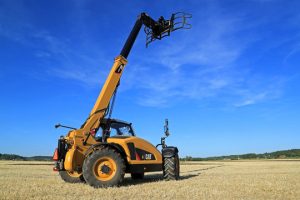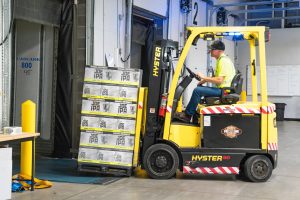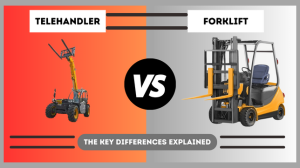In the world of material handling and construction, two key pieces of equipment often come to mind – the telehandler and the forklift. Both are invaluable in their own right, integral to a multitude of tasks on a job site. But what sets them apart? How do you choose between a telehandler and a forklift when it comes to your project needs?
In this article, we delve into the specifics of these two machines, comparing their strengths, weaknesses, and ideal applications. We aim to provide you with a comprehensive understanding of the telehandler vs forklift debate, empowering you to make an informed decision that optimises efficiency and productivity in your operations.
What is a Telehandler?
A telehandler, short for telescopic handler, is a versatile piece of machinery often seen in construction and agriculture sectors. Its primary feature is the extendable boom, which can reach heights that are typically inaccessible to other types of equipment.
Attached to this boom is a variety of possible tools, including buckets, pallet forks, muck grabs, or lift tables, making the telehandler adaptable to a wide range of tasks. From lifting heavy loads to high locations, to shifting materials over obstacles and onto scaffolding, the telehandler’s capabilities go beyond those of traditional forklifts.

What is a Forklift Truck?
A forklift truck, simply known as a forklift, is a powered industrial vehicle designed to lift and transport materials over short distances. Equipped with a pronged device in front, called forks, it can slide underneath a cargo to lift it off the ground and move it to a different location.
Forklifts are indispensable in many industries, they come in various types and sizes, each suited to specific tasks. Some are small enough to operate in tight spaces, while others are large and powerful enough to handle heavy-duty loads.
Despite their differences, all forklifts share a common purpose: to improve efficiency and reduce the burden of manual labour in material handling tasks. Whether it’s moving pallets of goods in a warehouse or transporting construction materials on site, forklifts play a crucial role in maintaining smooth operations.

Which Is More Suitable For Your Requirements, a Telehandler or a Forklift?
When choosing between a telehandler and a forklift, it’s essential to consider the specific requirements of your project or operation. Here are a few factors you may want to consider:
- Nature of Work: If your work involves a lot of heavy lifting, particularly at high elevations, a telehandler may be more suitable due to its higher reach and load capacity. On the other hand, if your operations mainly involve moving goods around in a warehouse or factory setting, a forklift could be a more efficient choice.
- Work Environment: The type of terrain you’ll be working on can also influence your decision. Telehandlers, with their four-wheel drive, can handle rough terrains and off-road conditions better than most forklifts. However, forklifts are ideal for indoor use or smooth, paved surfaces.
- Space Constraints: If you’re working in a tight space, the compact size and superior manoeuvrability of a forklift might make it a better option. In contrast, telehandlers, due to their larger size, may be more suited to open spaces.
- Budget: Cost is another crucial factor. If budget is a major concern, you might lean towards a forklift due to its lower purchase price, maintenance costs, and training expenses. However, if versatility and high lifting capacity are priorities, the higher cost of a telehandler might be justified.
- Versatility Needs: If you need a machine that can perform a variety of tasks beyond just lifting and transporting loads, a telehandler with its various attachments might be the better choice. But if your operations are more straightforward and primarily focused on lifting and moving palletized goods, a forklift should suffice.

What’s the Difference Between a Telehandler and a Forklift?
Let’s delve into the key differences between telehandlers and forklifts, examining their unique features, uses, and capabilities to help you understand which equipment is best suited for your specific needs.
Use Cases
- Telehandlers are particularly useful in construction and agriculture, where their reach and versatility come into play. They can lift materials to great heights, such as placing bricks onto a high-rise scaffold or lifting hay bales onto a loft.
- Forklifts, on the other hand, are ideal for warehouse operations and other environments that require short-distance transport of goods. They excel at loading and unloading trucks, moving goods around warehouses, and stacking pallets.
Design
- Telehandlers feature an extendable arm or boom, which allows them to reach heights and distances beyond the capacity of a standard forklift. The operator cabin is usually set to the side, providing excellent visibility.
- Forklifts are more compact, with a straightforward design featuring a lifting fork at the front. The operator’s cabin is typically located in the centre of the machine.
Load Balancing
- Telehandlers balance heavy loads using a rear counterweight and, in some models, stabiliser legs.
- Forklifts maintain stability by distributing load weight between wheels and employing a built-in counterweight at the vehicle’s rear.
Lifting Capacity
- Telehandlers, with their robust design and powerful performance, typically have a higher lifting capacity than forklifts. They are often capable of handling up to 6,000 kilograms.
- Forklifts, while having a lower lifting capacity, offer greater precision in handling and placing loads. Typically, they can handle weights ranging from approximately 1,000 to 3,000 kilograms.
Fuel Types
Both telehandlers and forklifts are versatile machines that can operate on various types of fuel, including diesel, gasoline, propane, and electricity. The choice of fuel often hinges on the specific demands of the job, the operating environment, and the machine’s design.
- Telehandlers, due to their robust build and high lifting capacity, are commonly used in outdoor environments like construction sites and farms. Given their extensive use outdoors and the need for powerful performance, telehandlers are most commonly powered by diesel fuel.
- Forklifts the choice of fuel can vary depending on the nature of the operations and the indoor or outdoor usage of the machine. While diesel and gasoline are still used, propane and electrically powered forklifts are most common, especially for indoor operations where emissions and noise must be kept to a minimum.
Lifting Heights
- Telehandlers excel in scenarios where high reach is required. They are typically capable of lifting loads to heights of approximately 15 metres (50 feet) or more, making them an ideal choice for jobs like construction and high-level warehousing.
- Forklifts are specifically designed for lower-level lifting tasks. Most models offer a maximum lift height of about 5 to 6 metres (15 to 20 feet). While they may not reach as high as telehandlers, forklifts offer greater precision in handling and placing loads, making them a preferred choice for many indoor operations.
Attachments
- Telehandlers, often referred to as the Swiss Army knives of the construction industry, are renowned for their versatility. This flexibility stems largely from the wide array of attachments they can accommodate, transforming them into multipurpose machines.
- Forklifts are primarily equipped with forks for lifting palletized loads, but their functionality can also be expanded with various attachments. Clamps allow forklifts to handle objects of irregular shapes and sizes, side shifters provide lateral movement of the forks for easier positioning, and rotators can turn the forks around 360 degrees, offering enhanced manoeuvrability.
Operator Controls
- Telehandlers require specialised training due to the complexity of the controls and the precision needed to handle the machine’s extendable boom.
- Forklifts also require operator training to ensure safe and efficient use, they are generally considered easier to operate due to their more straightforward controls.
The Benefits and Limitations of Telehandlers
Benefits of Telehandlers
- Versatility: As mentioned earlier, the ability to use a variety of attachments makes telehandlers incredibly versatile. They can perform multiple tasks, from lifting heavy loads to high elevations, to moving materials around a site, to even acting as a mobile work platform.
- High Reach: Telehandlers are designed to reach heights that other lifting equipment cannot. This makes them indispensable in construction sites, especially for tasks such as positioning beams or installing roofs.
- 4-Wheel Drive: Most telehandlers come with four-wheel drive, enabling them to handle rough terrains with ease. This makes them suitable for use in a variety of environments, including construction sites and agricultural fields.
- Large Load Capacities: Telehandlers can handle large load capacities, often several tonnes. This makes them ideal for heavy-duty tasks where large amounts of material need to be moved.
Limitations of Telehandlers
- Requires Specialised Training: Operating a telehandler requires specific skills due to the complexity of its controls and the precision needed when handling the extendable boom. This means operators need thorough training before they can use these machines efficiently.
- Limited Use in Tight Spaces: Due to their size, telehandlers may not be suitable for use in tight spaces. Manoeuvring them in confined areas can be challenging, making smaller equipment like forklifts a better choice in such scenarios.
- Higher Costs: Telehandlers are generally more expensive than other types of lifting equipment. Their purchase price, maintenance costs, and the expense of training operators can add up, making them a significant investment.
- Lower Speeds: While telehandlers are powerful, they typically operate at lower speeds compared to other machinery. This could potentially slow down operations, particularly over large distances.
The Benefits and Limitations of Forklift Trucks
Benefits Of Forklifts
- Manoeuvrability: One of the key benefits of forklifts is their manoeuvrability. Their compact size and tight turning radius make them ideal for navigating narrow aisles and tight spaces in warehouses or factories.
- Ease of Operation: While forklifts still require operator training, they are generally considered easier to operate compared to more complex machinery like telehandlers. Their controls are more straightforward, which can reduce training time.
- Efficient Load Handling: Forklifts are designed specifically for lifting and transporting loads. They can quickly move goods around a site, greatly improving efficiency.
- Cost-Effective: Compared to other heavy machinery, forklifts are relatively cost-effective. They have lower initial purchase costs, maintenance is usually less expensive, and operator training is often more affordable.
Limitations Of Forklifts
- Limited Reach: Unlike telehandlers, forklifts have a limited vertical reach. This can be a disadvantage in situations where items need to be placed at high elevations.
- Less Versatile: While forklifts are excellent at what they do, they aren’t as versatile as some other types of equipment. Their primary function is to lift and transport palletized goods, and while attachments can broaden their capabilities, they’re not as adaptable as machines like telehandlers.
- Restricted to Smooth Surfaces: Most forklifts are designed to operate on smooth surfaces and can struggle on uneven ground or in off-road conditions.
- Limited Load Capacity: While forklifts can handle a reasonable amount of weight, their load capacity is typically less than that of larger machinery like telehandlers. This could limit their use in scenarios where exceptionally heavy loads need to be moved.
Final Thoughts
Choosing between a telehandler and a forklift is not a decision to be taken lightly. Each of these machines has its own set of advantages and limitations, and the optimal choice largely depends on the specific needs and conditions of your project or operation.
Factors such as the nature of work, work environment, space constraints, budget, and versatility needs must all be carefully considered. In order to make an informed decision, it is crucial to match these factors against your unique requirements.
But how can you find the best equipment that meets your needs? Forkify, an online platform for comparing quotes from local dealers for telehandlers and forklifts, is a great resource.
Simply input your requirements and let Forkify find the most suitable options for you. This not only saves time but also ensures you get the best value for your investment! Make sure you explore all your options before making a final decision to ensure that you choose the machinery that will best serve your needs both now and in the future.
Find Your Perfect Forklift
Compare Quotes from Local Forklift Dealerships


Enter Requirements


We Find the Best Deal


Receive your Quote